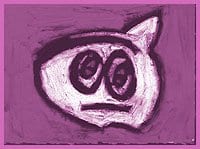Most of us exist with a certain amount of multiplicity or duality in our lives, whether that means we are profoundly shy in groups yet open and bubbly among friends, or a workhorse on the job but a sloth at home. In our roles as lovers, creative thinkers, workers, friends and family members, our multiplicity can range from the small and simple to the imm-ensely complex.
In the case of US artist Fargo Deborah Whitman, her complexity and multiplicity are a struggle to come to terms with but she is open and knowledgeable in helping others make that attempt.
Thirty years ago, when she was in her 20s, Whitman was one of the first women to have a solo exhibition at the Whitney Museum in New York City. In her 30s, she battled alcoholism and in her 40s she was diagnosed with disassociative identity disorder (DID), more commonly known as multiple personality disorder. Now in her 50s, she is 20 years sober and lives with more than 40 “alters” (voices or personalities) and is creating new artwork that is currently on display at the Bracket Gallery (an exhibition that includes catalogues of past work, drawings, sketchbooks, small sculptures and a large film-based sculpture installation).
The ability to make new work stems from her bravery to listen to her alters and understand that they have actual identities and are valuable to her survival as a woman, lesbian and artist.
Whitman describes an intricate interrelationship among her alters, the creation of a work and the final work itself. In creating a piece, she searches for a “process of expression,” finding subjects, forms and colours that allow her alters the freedom to create. That freedom may mean giving her body over to the cognitive level of six-year-old Genie or seven-year-old Anton.
Through this process, Whitman fashions a conduit through which her alters can interact with the world or with each other. To Whitman, therefore, the finished product is something metaphysical, what she calls “the soul of my internal community.”
Whitman’s drawings are captivating, employing a highly expressive palette of colour and line quality. While some images are stark black, white and gray, others explode with reds, blues and pinks. The meandering lines of oil stick smudges create remarkable depth. Most of the images are small, creating a confidentiality with the viewer. I longed to see large-scale, even mammoth, images absorbed in the same beautiful textures, colours and lines. It seems that her artistic process is beginning to ask that of her, as each drawing is pushed to the edge of the paper.
Bewildered monster faces peer out of the white frames in drawings with gummy surfaces. This provocative playfulness is nothing short of alluring. Dresses thickly layered with oil have severe charcoal outlines containing bursts of magenta and rose floating in creamy backgrounds with smears of black and red that connote joy and the movement of dance. Whitman’s alters seem to express a conflict with the gender binary – Anton is into dresses and disco while Genie is into trains and monsters. Perhaps this “andro-gyny,” as Whitman calls it, inadvertently addresses a larger queer community.
The film sculpture MaterMumma’s Shadow And What Used To Be There is a structure with strict solidity. Made of thick heavy wood and painted in matte black, it appears as a metal object, yet a delicate Super 8 film loop winds, circles through and envelops the structure, giving it a pierced vulnerability and fragility. The film, says Whitman, “is a literal narrative that attempts to catch the sublime.” During the opening, however, due to space limitations, the film was not projected leaving the piece, with its undeniable weight and presence, only to evoke a minimalist tradition of shape, simplicity and density.
Clearly, Whitman’s mental health issues sustain a fascinating and educational story. But it would be a disservice to her work and our understanding of it to view the show solely on those terms. The conflict and negotiation that Whitman must endure is not present on the exterior of the works, it is shown only metaphorically as all the pieces have continuity in expression and possess the professionalism and coherence of a solid body of work.
In Whitman’s serial drawings of indigo blue panels, again, colour is pushed to the very edge of the paper. Charcoal outlines of spheres bounce and rotate. Some appear as eggs, some testicles and others just form. They are reminiscent of Shel Silverstein’s book The Missing Piece Meets The Big O, in which a shape searches for its partner to fill its void. The metaphor of displacement and desired “wholeness” in Silverstein’s book seems to mirror Whitman’s indigo drawings, where spheres bump, congeal and separate in an attempt to somehow connect. Disparate aspects of her have found some peace and beauty.
“I knew I would have to accept it or die,” says Whitman. “I got tricked into loving a part of myself because they are a part of me. I had to accept that I am lovable.”
* A Fine State This Is continues at the Bracket Gallery (1168 Queen St W) until Sat, Dec 11; call (416) 538-2659.

 Why you can trust Xtra
Why you can trust Xtra


